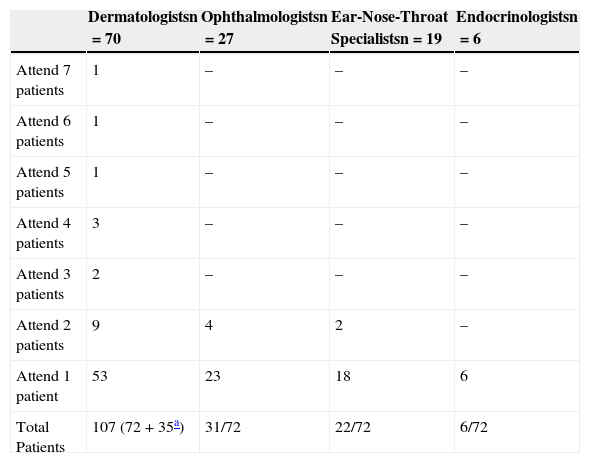Congenital ichthyosis is a very rare genetic disease—an estimated 294 patients in Spain are thought to be affected.1 The disease usually has a large impact on patients’ quality of life because, regardless of the type of ichthyosis, patients may experience intractable pruritus, hyperhidrosis, failure to thrive during childhood, cicatricial alopecia, repeated keratitis, conductive hearing loss, and social problems in addition to cutaneous manifestations. As a result, in addition to dermatologists, most patients need to be attended by other specialists such as ophthalmologists, ear-nose-throat specialists, endocrinologists, nutrition experts, and psychologists. If it is rare for many dermatologists to see a patient with ichthyosis, it is easy to imagine the limited experience that many of these other specialists have.
During the first quarter of 2014, we conducted a survey of the members of the Spanish Ichthyosis Association (abbreviated as ASIC in Spanish) to find out the name of the attending physicians. Our aim was to determine whether dermatologists, ophthalmologists, ear-nose-throat specialists, and endocrinologists had experience in ichthyosis. Seventy-two ASIC members responded; in addition, ASIC has data on the dermatologists who attended a further 35 patients. In total, the ASIC members mentioned 70 different dermatologists. Of these, only 3 were mentioned by more than 5 different patients, 5 were the regular dermatologist for 3 or 4 patients, 9 saw at most 2 patients regularly, and the remaining dermatologists (up to a total of 53) were mentioned by a single patient. A similar picture emerged with the other specialists, who were mentioned in the survey by at least half of the patients: 4 ophthalmologists were mentioned by 2 different patients, only 1 ear-nose-throat specialist was mentioned by more than 1 patient, and no endocrinologist of the 6 mentioned had more than one patient with ichthyosis (Table 1). Interestingly, several members highlighted that although they regularly attended appointments with these specialists, they were not usually seen by the same physician. In summary, our survey shows that very few physicians have experience with a significant number of patients with ichthyosis, and that it is likely that most patients are not attended regularly by other specialists who could help them with some of their possible comorbidities.
Proportion of Patients With Ichthyosis Who Were Attended by the Same Specialist, According to the April 2014 Survey of Members of the Spanish Ichthyosis Association (ASIC).
| Dermatologistsn=70 | Ophthalmologistsn=27 | Ear-Nose-Throat Specialistsn=19 | Endocrinologistsn=6 | |
|---|---|---|---|---|
| Attend 7 patients | 1 | – | – | – |
| Attend 6 patients | 1 | – | – | – |
| Attend 5 patients | 1 | – | – | – |
| Attend 4 patients | 3 | – | – | – |
| Attend 3 patients | 2 | – | – | – |
| Attend 2 patients | 9 | 4 | 2 | – |
| Attend 1 patient | 53 | 23 | 18 | 6 |
| Total Patients | 107 (72+35a) | 31/72 | 22/72 | 6/72 |
It is important to highlight possible biases in our survey. On the one hand, not all patients with ichthyosis belong to the ASIC (in fact, we have the names of dermatologists who attend approximately one third of all Spanish patients), and so the data only partially reflect the true situation. On the other, it is logical to think that dermatologists who recommend joining the ASIC are those who are more strongly represented in the survey. In any case, the proportion of dermatologists, ophthalmologists, and ear-nose-throat specialists who attended a single patient is noteworthy and probably reflects the true situation: most patients with ichthyosis lack a multidisciplinary follow-up, and are also seen by specialists with few other similar patients.
In rare diseases, to become an expert requires experience, but this can only be acquired if professionals attend a significant number of patients. The creation of official reference centers would help referral of patients and group a significant number of them together. This in turn could help to improve the care that they receive.2
Please cite this article as: Hernández-Martín A, Dávila'Seijo P, Soria de Francisco J, Arroyo-Manzanal M, García-Doval I. Dispersión en la atención médica de los pacientes con ictiosis. Actas Dermosifiliogr. 2015;106:514–515.





